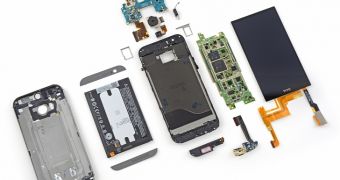Soon after its official unveiling, the brand-new HTC One M8 smartphone from HTC saw its first teardown, providing users with the possibility to have a closer look at the high-end hardware packed inside it.
The mobile phone, introduced yesterday with a 5-inch touchscreen display, a quad-core Snapdragon 801 processor inside, and an Aluminum body, did not appear to be as easy to repair as one might have hoped it to be, at least this was what the guys over at iFixit found out.
As far as one can see, the phone’s rear case can be removed quite easily, as the phone comes with a series of screws that make this action a simple task.
However, things are not the same once anyone goes deeper inside the new HTC One M8, it seems, as there’s a lot of tape inside the phone, along with almost a dozen cables that need to be disconnected in order to get to the motherboard.
Apparently, HTC One too was in a bad shape when it came to repairability, and things are not much different when the new device is involved, though they do appear to have been improved.
Once all cables and tape are removed, and the motherboard is brought to light, anyone who decides to tear the handset to pieces can start having a closer look at the internals.
There’s a lot to see there, that’s for sure, starting with the 2.3GHz Qualcomm Snapdragon 801 CPU and the Elpida FA164A2PM 2GB RAM, and going all the way to the SanDisk SDIN8DE4 32GB NAND flash memory.
The phone also includes Qualcomm PM8941 and PM8841 power management ICs, a Synaptics S3528A touchscreen controller, and Avago ACPM-7600 power amplifier module.
The handset also comes to the market with a 2600mAh battery, which, unfortunately, cannot be removed unless the motherboard is freed first.
Other internals of the smartphone include the 4-megapixel UltraPixel camera on the back, paired with a secondary rear camera, to which a 5MP front camera is added, for great video chatting capabilities.
There is also an NXP 44701 NFC controller inside the device, along with a Qualcomm QFE1550 dynamic antenna matching tuner, the HTC BoomSound speakers, micro-USB port, and the like.
After all of these pieces are removed from the handset, the display can come off as well. However, it seems that the screen is the hardest to remove, which makes it great that HTC has already announced that it will be offering a free screen replacement to those who break it in the first six months.
According to iFixit, the overall HTC One M8 Repairability Score would actually be 2 out of 10, which means that users grabbing the device should take extra care when it comes to it. However, the phone’s body has been built strong on the outside, which improves its durability.

 14 DAY TRIAL //
14 DAY TRIAL //